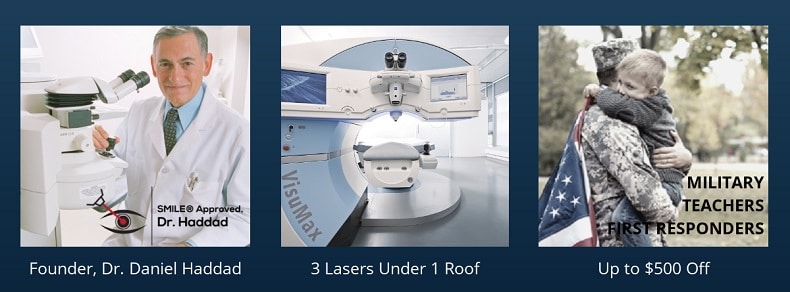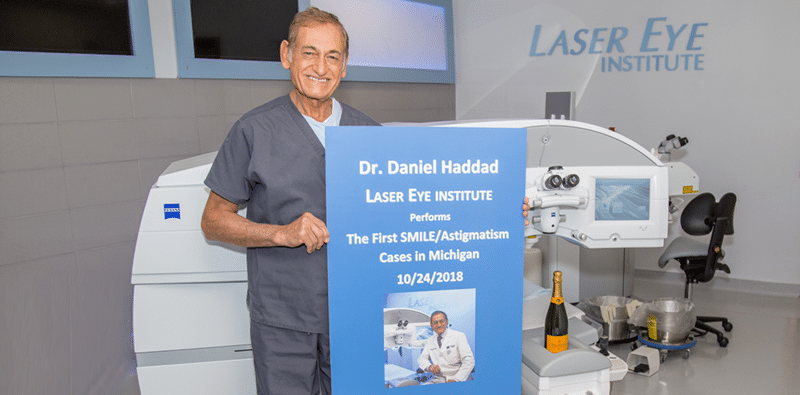LASIK, LASEK, & ReLex SMILE: 2019 Facts
The year is 2019 and information is more accessible than ever. Within a few clicks, we can arrive on anything from a political meme to a scientific published white paper; we can form an opinion and share it with our friends and family – quickly and easily. We live in an information era, which can be powerful and dangerous; taking the proper precautions in what we deem as fact versus opinion is paramount.
My goal for this article is to deliver you the facts about Laser Vision Correction (LVC), and deliberately counter the misleading information that exists on the internet today. I will be objective, I will cite reputable sources, and I will present the information needed for you to make an educated opinion (and maybe even get you to schedule a consultation).

How common is Laser Vision Correction (LVC)?
If you look at the most common surgeries in the U.S., laser vision correction is in the top echelon of proven medical procedures; there are roughly 600,000 laser eye procedures done in the U.S. every year (millions across the globe). At a patient satisfaction rate north of 98%, it is also one of the most successful medical procedures performed to cure Myopia, Hyperopia, and Astigmatism.
What are the differences between LASIK, ReLex SMILE, and LASEK (PRK)? Is one better than the other?
The short answer is “no.” The important takeaway is that there are options and the (3) options are so similar, most patients don’t even know the difference. Your diagnosis, age, lifestyle, and more will play a part in determining what the best laser vision correction treatment is right for you. I am not going to get into a world of details, but at the highest level the differences are as follows:
LASIK – LASIK is a type of refractive surgery for the correction of myopia, hyperopia, and astigmatism. During LASIK a microscopic, protective flap is created to access the inner cornea. Then, laser light is used to gently reshape the surface of the cornea to alter its focusing power and improve your vision. Lastly, the protective flap is positioned to protect the eye and aid in healing. For most patients their vision improves immediately after treatment
LASEK (PRK) – LASEK is similar to LASIK, but uses a different method to expose the cornea for laser treatment. In LASEK, instead of a flap, the surface of the eye is treated, and then laser treatment is applied. A bandage contact lens is placed over the eye afterwards to promote healing and provide protection. Vision improves gradually after LASEK and the bandage contact lens is removed after about one week
ReLex SMILE – SMILE, while related to LASIK, works differently. Treatment is instead applied slightly below the surface of the eye. This method is even less invasive than LASIK and overall a gentler procedure. Patients whom did not qualify for LASIK may now qualify for SMILE. Dr. Haddad was the first surgeon in Michigan to perform SMILE in 2017 (first to perform SMILE for Astigmatism in October of 2018)
Are LASIK, ReLex SMILE, and LASEK (PRK) Safe?
With any medical procedure, there are always risks, however LASIK, ReLex SMILE, and LASEK (PRK) have a significantly low complication rate and is a safe and proven procedure. Since 1996 nearly 20 million U.S. people have had some type of laser vision correction treatment. New advancements in technology and overall experience makes it safer, less invasive, and boasts quicker recovery time than ever before.
Can I go blind from LASIK, ReLex SMILE, and LASEK (PRK)?
When people inquire about LVC, I often hear this question: “Can I go blind from LASIK?” I am not here to tell you there isn’t a risk, however according to the American Refractive Surgery Council, there has never been a case where LASIK was the primary cause of blindness.
In theory it can happen, and statisticians arrived on a number of 1 in 5 million. To put that into perspective you have a much better chance of becoming a move star (1 in 1.19 million), getting attacked by a shark (1 in 3.75 million), or getting struck by lightning (1 in 12,000).
When you select the most reputable surgeons and best facilities, your chances of having serious complications are even more unlikely. Remember, all LVC isn’t created equally. Look for experience, technology, and reviews when researching your doctor.
What are common side effects from LASIK, ReLex SMILE, and LASEK (PRK)?
The most common side effects include dry eyes, glare, halos, ghosting and starbursts; however, most of these symptoms will subside and go away during the natural healing process. Nationally, up to 30 percent of patients experience dry eye symptoms in the first 3 months after surgery; however the latest Laser Eye Institute numbers indicate around 20% experiencing dry eyes after LASIK/LASEK. Less than 5% of patients experience dryness with ReLex SMILE – the most advanced form of LVC.

Final thoughts about LASIK, ReLex SMILE, and LASEK (PRK)
It is inherently human to have doubts or fears about the “unknown.” In the age of social media, a post here or some comments there (right or wrong) can significantly influence your opinion. I encourage you to study the facts and use reputable sources (including clinical studies) to formulate a well-rounded and educated opinion about LVC, and if it is right for you. Like I mentioned in the introduction, see below for a list of sources I recommend for research.
What are your thoughts about LVC? Do you think it’s right for you?
Sources:
American Refractive Surgery Council
American Society of Cataract and Refractive Surgery
American Academy of Ophthalmology
U.S. Food & Drug Administration
Share This Article
Posted by Dave Lemieux
David Lemieux, BA from Oakland University is a LASIK expert and marketing professional that has worked with Dr. Dan Haddad and the Laser Eye Institute since 2017. David believes in education and cutting through the noise to deliver facts and opinions about LASIK, SMILE, and all things Laser Vision Correction.
